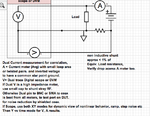mtwieg
Advanced Member level 6
Re: Confiused about how to calculate effective power/voltage/current of a pulse wave
It makes sense when power is being transduced into some other signal in a linear fashion, and you which to know the RMS of the resulting signal, not its average power. In these cases, RMS is interesting because for AC waveforms it is also the standard deviation, which is often of interest.My doubt is about applying the RMS specific calculation to power quantities, squaring instantaneous power values. I don't see a technical relevance for it, because power already represents squared magnitude (current, voltage, sound pressure, whatsoever) values.

